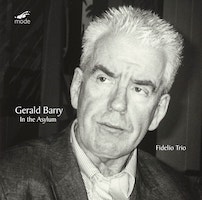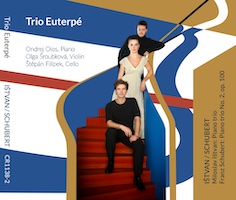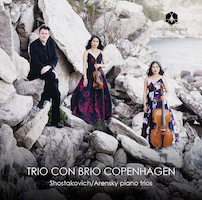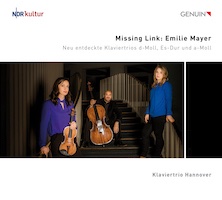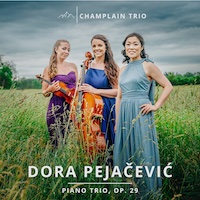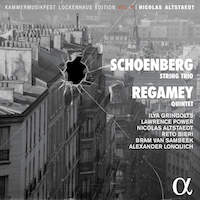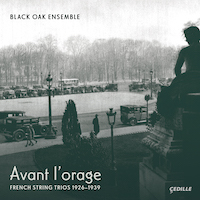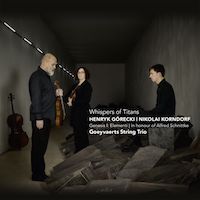String Theory 40: Piano Trios, String Trios
|
Grant Chu Covell [July 2023.] Alongside the presumed classics (Schubert, Arensky, Shostakovich and Schoenberg) among the releases in this grouping, the Barry ought to be the most enduring. Some later day I will explain why I strongly believe that the sustaining path forward for new music is through the past, but for now, my enthusiasm for the vital and invigorating Barry will have to suffice.
“In the Asylum.” Gerald BARRY: 1998 (1998)1; All day at home busy with my own affairs (2015)2; Midday (2014)3; Le Vieux Sourd (2008)4; Baroness von Ritkart (2010)5; In the Asylum (2000)6; Ø (1979)7; Triorchic Blues (1990)8. Fidelio Trio: Darragh Morgan1,3,5,6,7,8 (vln), Mary Dullea1,3,4,5,6,7,8 (pno), Adi Tal6,7,8 (vlc), Gerald Barry2 (pno), Rose Redgrave7 (vla). mode 332 (1 CD) (www.moderecords.com). It may surprise that a composer given to music which sounds haphazard and free of contours could be so effective at opera. Barry’s music can be unexpectedly blunt, but it is charismatic, nonetheless. He is a master of the wry title which like a magician’s banter casts our attention elsewhere. We have encountered the Fidelio Trio many times before (here, here and here for starters), but now they are stretched to perform indifferently which they do alarmingly well. 1998 occupies violin and piano for nearly 22 minutes. The duo proceeds simultaneously, but their short phrases and insistently repeated pitches do not demonstrate togetherness. This piece could be a collage, or the remaining notes after some systematic erasing process. Another violin and piano combination, Midday, commences with a repeating seven-beat phrase, mostly silent, but persistent like a dripping faucet. New material intrudes, gestures are repeated, but without apparent development. A third duo, Baroness von Ritkart (after a Chekhov character), is apparently a palindrome chopped into three parts: “Clever, noble, but not talented,” “Talented, noble, but not clever,” and “Talented, clever, but not noble.” We try and fail to align the movement titles with what we hear. Barry takes to the keys for his All day at home busy with my own affairs sounding like someone who has never played the piano, playing with just two fingers. (Barry avoids pedal. Other pieces carry instructions along the lines of: “No pedal – ever. Keep your feet far away from them.”) Near the midpoint it sounds as if the material repeats, but not quite. Later Dullea offers the solo piano Le Vieux Sourd which requires more fingers and coordination as it obstinately tears though its quirky tune. “Le Vieux Sourd” (“The Old Deaf One”) was Debussy’s nickname for Beethoven. This raucous solo enfolds a setting of Auld Lang Syne (it also appears in Barry’s opera The Importance of Being Earnest, and All day at home appears in Salomé). The score of In the Asylum (piano trio) provides a perplexing note: “In the Asylum comprises three pieces: The Rung, The Potent Rug, and Wigs of Flanders.” Apparently, these titles are mishearings: again, more dissembling. Perhaps you can pick out three sections. There are unexpected unisons, capricious changes of mood. Many of Barry’s pieces exist in multiple versions (there is a version of Midday for eight horns and two wind machines). For this release we hear Ø for piano quartet (originally for two pianos) and Triorchic Blues for trio (also a solo for piano or violin). Ø or “symbol” is played in unison. An expanse of quiet quarter notes wanders between longer notes before a closely related louder and rhythmic version. Where Ø was slow and regular, Triorchic Blues is a rhythmically complex and inexorable manic acceleration. The title obscurely refers to castrato Giusto Ferdinando Tenducci who was reputedly “triorchic” or triple-testicled.
“Trio Euterpé.” Miloslav IŠTVAN: Piano Trio (1958). Franz SCHUBERT: Piano Trio No. 2 in E-flat major, Op. 100, D. 929 (1828). Trio Euterpé: Ondrej Olos (pno), Olga Šroubková (vln), Štěpán Filípek (vlc). Český rozhlas CR1138-2 (1 CD) (www.radioteka.cz). The Piano Trio by Czech composer Miloslav Ištvan (1928-90) is in four movements. Let’s confront the Bartók comparison directly: Ištvan’s incorporation of folktunes and cyclic development does suggest the Hungarian master, however, I imagine late Bartók disdaining the classic structure, whereas Ištvan embraces it readily thereby aligning himself with late Romantic examples such as Ravel’s Trio or any by Dvořák. Ištvan’s Scherzo, marked Presto Martellato, assuredly brings us into the 20th century with its contrapuntal dissonance. If Trio Euterpé gave us only the Ištvan, we should be satisfied. However, the program concludes with a marvelous performance of Schubert’s big second Trio. I admit that Schubert’s E-flat Trio has become a modest obsession the past few months, enabled by the Euterpés. This quintessentially late Schubert opus approaches perfection. Yes, it is long, at a nascent Brucknerian scale. The Euterpé’s approach is fresh, with gentle pauses and subtle stresses in the opening and in the Scherzo revealing different ways to look at the main themes. I could listen to this all day.
Dmitri SHOSTAKOVICH: Piano Trio No. 1 in C minor, Op. 8, “Poème” (1923); Piano Trio No. 2 in E minor, Op. 67 (1944). Anton ARENSKY: Piano Trio No. 1 in D minor, Op. 32 (1894). Trio con Brio Copenhagen: Soo-Jin Hong (vln), Soo-Kyung Hong (vlc), Jens Elvekjaer (pno). Orchid Classics ORC100181 (1 CD) (www.orchidclassics.com). Arensky’s Trio might not be one of the greatest trios of all time, but it certainly can hit the spot in a passionate performance. This is perhaps the only Arensky I would recognize or perhaps be able to recall. There’s a moment in the first movement towards the close of the exposition where soaring strings and busy piano momentarily trade places, the piano offers a chordal cadential figure, the strings zip upwards in an arpeggio, the piano repeats, and the strings zip down. Wrapped in a subtle tempo change, this passage always delights. Shostakovich’s first Trio is a varied single movement, perhaps unsure what to do with itself as it jumps between sweet and sour. The composer was just sixteen when he wrote this, and so the drama is representational. Some twenty years later, in the second Trio, we experience a mature Shostakovich who could be bitter, frightened and sarcastic. Fewer notes speak volumes, and quotations flash signals into the void. The Trio con Brio Copenhagen deliver No. 2’s Scherzo with ardent acidity.
“Missing Link: Emilie Mayer.” Emilie MAYER: Piano Trio in D minor (1845-55); Piano Trio in E-flat major (1845-55); Piano Trio in A minor (1859). Klaviertrio Hannover: Katharina Sellheim (pno), Łucja Madziar (vln), Johannes Krebs (vlc). Genuin GEN 22790 (1 CD) (www.genuin.de). Dora PEJAČEVIĆ: Piano Trio in C Major, Op. 29 (1910). Champlain Trio: Hiromi Fukuda (pno), Letitia Quante (vln), Emily Taubl (vlc). Champlain Trio (streamable) (www.champlaintrio.com). Prolific by any standards (at least eight symphonies and countless sonatas, quartets and trios), Klaviertrio Hannover introduces us to Emilie Mayer (1812-1883) who maintained aspects of the Classical style into the Romantic era. These three Mayer trios (Wikipedia indicates the presence of eight) receive their first performances. The D minor trio exists in several versions (different outside movements) and is contemporaneous with the E-flat trio which is the more interesting of these three. Not quite as quirky or adventurous as Haydn and much lighter than either Mendelssohn or Schumann, Mayer’s material progresses effectively from one place to another, and the invention is modest. Honestly, these trios would rock if the piano were swapped with a fortepiano. Dora Pejačević (1860-1923) is regarded as an important Croatian composer, the first of her country to write a piano concerto. The Trio (about 34 minutes) is a late-Romantic piece with lively harmony and melodies not unlike Korngold or Fauré. A comparison with Mayer would be unfair considering Pejačević’s vastly different harmonic language, but the later composer easily varies the pulse within a phrase, neatly developing rhythmic gestures to create surprise and tension. Mayer is operating within Classical conventions, and her development is more subtle. The Champlain Trio came together during 2020, and in 2022 was awarded a grant from the Vermont Arts Council to prepare and record Pejačević’s Trio. The dedication and devotion shows.
“Kammermusikfest Lockenhaus Edition, Vol. 4.” Arnold SCHOENBERG: Sting Trio, Op. 45 (1946).1 Constantin REGAMEY: Quintet for clarinet, bassoon, violin, cello and piano (1942-44).2 Ilya Gringolts1,2 (vln), Lawrence Power1 (vla), Nicolas Altstaedt1,2 (vlc), Reto Bieri2 (clar), Bram Van Sambeek2 (bsn), Alexander Lonquich2 (pno). Alpha 948 (1 CD) (www.outhere-music.com). The Schoenberg Trio might be one of those greatest pieces you’ve never heard. Forget all you know about Schoenberg, whether it be the “difficult” music or even the heightened tonality of Verklärte Nacht. The Trio can be ornery, however, it is powerfully expressive and offers a story not unlike a tone poem. Op. 45 is as serious as a heart attack because that is what the work is about. In his Trio, Schoenberg describes his near-fatal physical experience, his pain, fear, and uncertainty, the life-saving injection and the male nurse who aided him. On other recordings the Trio is often treated as an appendix to the Quartets, but here, Gringolts, Power and Altstaedt provide passion and focus. As trios go, the work is well balanced and vigorous, although analytically it is fragmentary and digressive, demonstrating how Schoenberg could wriggle around his own twelve-tone rules. Regamey’s Quintet may be among his most popular efforts, but it’s nevertheless obscure. Born in Kiev, Regamey completed his education in Warsaw, worked in the Resistance in the 1940’s and left Poland for Switzerland in 1944 after the failed Warsaw Uprising. Like his onetime compatriot Lutosławski, Regamey played the piano in cafés. The Quintet was written 1942–44 and premiered on June 6, 1944. Perhaps attributable to lingering effects of this program’s opener, the Quintet is suffused with anxiety. Sonically, there is a similarity with Messaien’s Quatuor though Regamey’s Quintet adds bassoon, and his piano writing is more florid. The three movements’ language is close to Schoenberg’s Chamber Symphony No. 1, although Regamey incorporates twelve-tone technique to add piquancy to harmony.
“Avant l’orage: French String Trios 1926-1939.” Henri TOMASI: Trio à cordes en forme de divertissement (1938). Jean CRAS: Trio pour violon, alto et violoncelle (1926). Émile GOUÉ: Trio pour violon, alto et violoncelle (1939). Jean FRANÇAIX: Trio (1933). Robert CASADESUS: Trio à cordes (1938). Gustave SAMAZEUILH: Suite en trio pour violon, alto et violoncelle (1937). Gabriel PIERNÉ: Trois pièces en trio (1937). Black Oak Ensemble: Desirée Ruhstrat (vln), Aurélien Fort Pederzoli (vla), David Cunliffe (vlc). Cedille Records CDR 90000 212 (2 CDs) (www.cedillerecords.org). This is a curious and generous collection, but one may well wonder why these works are so unfamiliar. As expected from this epoch, they are all pleasantly tuneful with essentially no avant-garde effects. Fine tuning the focus elicits details and no interchangeable parts. The storm of the series’ title is presumably WW II; these trios reflect a comfortable, uncomplicated and unhurried world. Perhaps these composers may be known because of other contributions: Tomasi wrote a popular trumpet concerto, Casadesus was an accomplished pianist, Cras was a Navy officer and inventor. Five of these trios were written for the Trio Pasquier (brothers Jean, Pierre and Étienne): Casadesus, Françaix, Pierné, Samazeuilh and Tomasi. (Étienne was imprisoned with Messiaen and was the premiering cellist of the Quatuor pour la fin du temps in 1941.) Françaix, Samazeuilh and Tomasi may be more allied with neo-classical trends; Cras and Goué, can camp with Ravel. Casadesus and Pierné are somewhere in between, combining melody and straying harmony. Francaix’s Trio is bright and flirtatious. Pierné creates motifs from the Pasquiers’ names and develops them across three movements. I explored this collection multiple times in different orders, and the Tomasi and bits of the Samazeuilh stick most.
“Whispers of Titans.” Henryk GÓRECKI: Genesis I: Elementi per tre archi, Op. 19, No. 1 (1962). Nikolai KORNDORF: In Honour of Alfred Schnittke (AGSCH) (1986). Goeyvaerts String Trio: Kristien Roels (vln), Kris Matthynssens (vla), Pieter Stas (vlc). Challenge Classics CC72713 (1 CD) (www.challengerecords.com). Generally newish releases find their way into these multi-item roundups. Mentioning this item skews precedent (it’s from 2016), but because it’s an exception, a quick note will suffice. The Goeyvaerts has recorded several avant-garde sides of string trio music (Schoenberg / Webern / Schnittke, Gubaildulina / Paiberdin / Kancheli / Knaifel, Pärt / Moody). Here are two immensely different pieces: the Górecki is freewheeling aleatoric mayhem, the Korndorf a bustling tonal expanse. This trio’s playing is at a different level than most.
Arensky, Barry, Casadesus, Cras, Francaix, Górecki, Goué, Ištvan, Korndorf, Mayer, Pejačević, Pierne, Regamey, Samazeuilh, Schoenberg, Schubert, Shostakovich, Tomasi
[More Grant Chu Covell, String Theory]
[More
Arensky, Barry, Casadesus, Cras, Francaix, Górecki, Goué, Ištvan, Korndorf, Mayer, Pejačević, Pierne, Regamey, Samazeuilh, Schoenberg, Schubert, Shostakovich, Tomasi]
[Previous Article:
Maestro di Suoni e Silenzi 7: A Reissue and a Revisit]
[Next Article:
Used Bin Troll Tweets OOO.]
|
